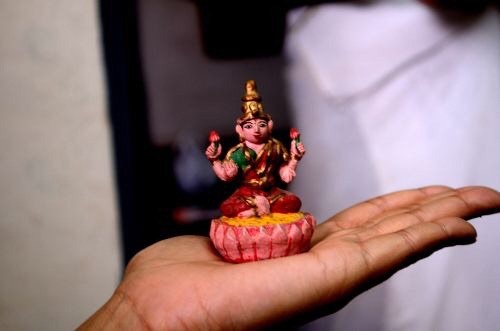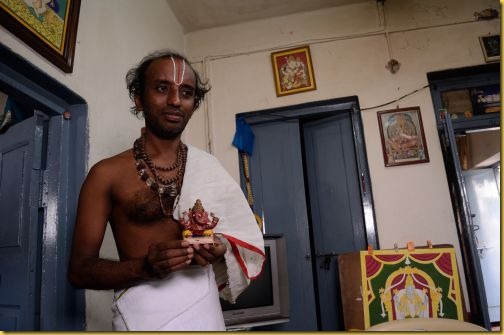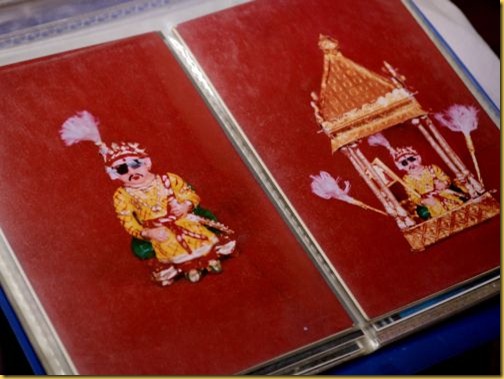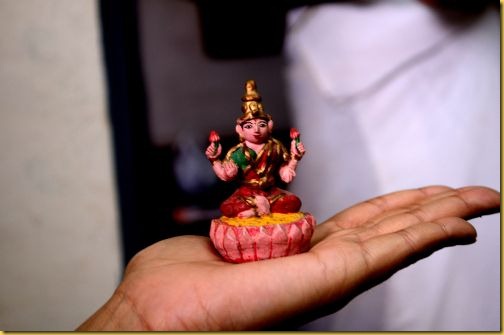Meet Mysore artist Venkatesh

It is a busy day and the crowds are milling towards the palace in the royal city of Mysore. I take a detour and enter a quiet part of the city which is wrapped in an afternoon siesta. A light breeze awakens the spirit as I wander around looking for people with a royal connect. A chance conversation with a friend , Vinay from Royal Mysore Walks takes me to the doorstep of an artist , Venkatesh whose nostalgic memories lead us through a fascinating journey as he shares snippets and stories from the lives of his ancestors.
The leafy environments greet me the moment I step into the lane where Venkatesh lives. Tall trees create a canopy as the detour ends into a dead-end. Plump and ripe, the “chakotas” are dangling from the branches of the tree, waiting to be plucked. Venkatesh smiles and ushers us in , while his sister is waiting for us with a cup of tea.
I look around and see in the dim afternoon light . The walls are filled with paintings and sculptures taking you into a different era. A Raja Ravi Varma painting hangs on the wall, but as you look inside, you see a Mysore painting of Krishna dancing on the snake Kalinga . A painting of the deity, Lakshmi Narasimha graces the walls , while the Goddess Saraswati sits gracefully on the other side.
Amidst the medley of Gods and Goddesses are several weapons , that dates back to the Vijaynagar empire . Venkatesh explains that his ancestors who came from those regions were employed in different positions in the royal palace – some of them served as surveyors, while others were personal body guards of the kings.
He tells us that they were referred to as “ Girle Meesai Sepoy” and they looked ferocious with thick curled moustaches that used to spread to their ears. As personal body guards of Maharaja Krishnaraja Wodeyar 111, they could walk around barefoot anywhere in the palace and were given the task of protecting the queen. “They wore their turbans or petas ‘round’ , “ explains Venkatesh , adding that they were of a ‘betelnut colour’ and were tied using a fabric that was like an eight metre saree .
Venkatesh’s fascination with the turbans started at a very young age and he learnt the art of tying them from his father . “ Every community or nobility, in fact anyone who had to go to the aramane (palace) had to wear a turban and each of them had its own style . The width of the zari in the peta was based on the grade of the nobility and the person employed in the palace,” adds Venkatesh . Although his family did not look at this as a profession, most people who visited the palace stopped by at their house to get their turbans styled. “ We used to tie them for people during weddings and functions and I styled the bommais (dolls) for Dussehra, especially the ‘pathadu bommais,’ “ he adds, referring to the wooden dolls, also called as Marapachi bommai.
Venkatesh ‘s pride however are the miniatures that he has created – the throne of the Wodeyars, the Ambaari (howdah) that is carried during the procession and a model of the present Wodeyar himself . Wrapped in golden paper after being carved in clay and cardboard, he uses other materials like golden foil and even wires to hold these miniatures together.
The man is a storehouse of stories. He can talk in ease about every style of turban – be it the kings of the Vijaynagar era to the Marathas to the Mysore Maharajas. He then drapes a turban around his head and mentions that it is slightly tilted to a side, as it is believed to be dressed on the lines of Krishna, who is followed by his community , Gollars. He then suddenly breaks into hymns and talks about how the kings of those eras protected their subjects and even their thrones symbolised the same. He narrates an incident when his great grandfather’s grandfather , who was a surveyor at the palace, requested the king to change a line in his prayer. “ My father told me this story . The king used to pray, “let my enemies be vanquished,” But my ancestor asked him to pray “ Let my enemies become friends .”
We sip more tea and listen to more stories and the conversation moves on towards his current life. Venkatesh who learnt Mysore style of painting at a young age from the erstwhile curator of the palace ekes his livelihood through painting and by teaching the art to several students . He takes us through his technique as he tells us that he has painted on every surface – from wood, to glass, to fabric, to aluminium and even on walls . The colours are prepared naturally at home and he uses natural and vegetable dyes to create them . “ The panchabhootham colours are the main and then I create more colours such as ivory black which is charred cotton mixed with gum. “ he adds. The style is also very distinct with delicate lines and brushstrokes that differentiate it from the parent Vijaynagar style of painting. And then he elaborates on the gesso work, which refers to the gold relief work on the embossed painting.
We see a variety of paintings that he has created- from miniatures to paintings decorating the wall. He recalls with fondness the painting of Govardhana giri that he gave to present Wodeyar king during the Dasamana utsav. His house is a veritable art gallery, but Venkatesh is lost, living in his own world of colours and stones .
This story was published in Spectrum, Deccan Herald last week.




Lovely!
What a wonderful encounter.
This was a very useful article, we need to know more about this art and artist can you plese provide his contact. Or any information because we are going to Mysore and we would love to know this art.
Thank you